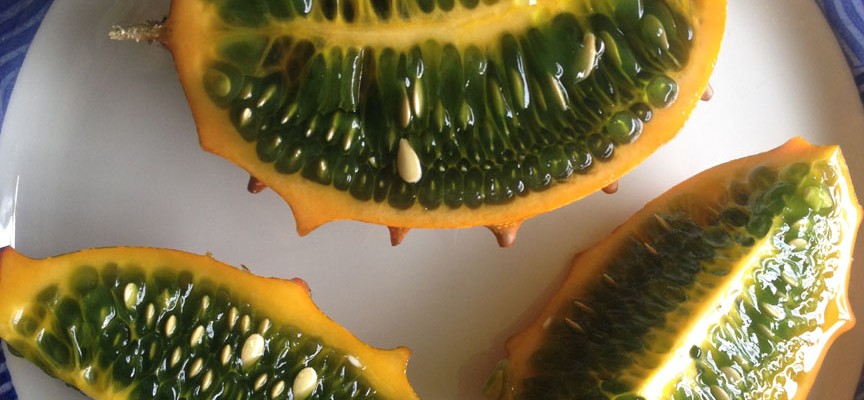
Horned melons
I was in our local natural food store in the refrigerator section when I first saw this spiky yellow orb. As I was turning it over in my hands, the produce manager came up to me and told me that it was a horned melon from Africa. She said I should try planting some of the seeds and that the thick skin of the horned melon would grow well in our environment–which is plagued by the oriental and melon fruit fly.
It seemed like a good idea and I love experimenting with new fruits, so I purchased it and brought it back to the farm.
When I cut it open I was surprised to find a beautiful green color, cucumber-like interior. Hundreds of seeds encased in individual gel sacks make up the entire fruit. I sliced it into sections and slurped it up.
The texture was somewhat a cross between a watermelon and a cucumber. I was expecting a sweet flavor but it’s more tart. It’s very hydrating and rejuvenating. I sprinkled a little salt on a slice for a more savory flavor. It’s the perfect fruit to eat on a hot summer day.
I removed a few of the seeds and soaked them allowing them to ferment to easily remove the gel coating for planting. Most all the seeds seemed viable. No flexible flat seeds that you sometimes find in cucumbers. I started them in pots and decided to first grow them in my screen house. I didn’t want to risk loosing the fruit to fruit flies and I wanted to make sure I got more viable seeds.

Horned melon vines
The plant is extremely hardy and climbed up a trellis like a cucumber. The leaves are small and the entire plant is covered in fine hairs that can be pokey enough on the vines to penetrate one’s skin. Numerous female flowers cluster together and are easy to hand pollinate. It seems to have flushes of blooms just like cucumber.
I grew three plants and I got well over a hundred horned melons. In fact, I’m still getting them from two out of the three. The plant doesn’t seem to suffer from powdery mildew or root knot nematodes.
The fruit has an extremely long shelf life –at least a month and does not need to be refrigerated. I have yet to see one go bad!
They seem to grow very rabidly but remain green for quite a while before they turn yellow. In fact, I think the hotter summer weather has helped them speed up the ripening process.
On each fruit, there are numerous spiky points and at the end of each one is a thorn. The thorn is hard enough to break skin and must be removed. I used a pumice stone and brushed them away under running water.

Growing on vine
The only pest that seem to be attracted to them was scale and spider mites. Though nothing really phased them.
These melons grow in the Kalahari desert, if that tells you anything. If you were lucky enough to come across these melons in the desert you’d be a happy hiker most certainly. They are also grown in New Zealand and California.
I have yet to try them in the open garden but I am going to try. I think they might get stung by fruit flies but they have a strong will to survive and I’ve seen them heal wounds and keep on growing.
I will keep experimenting with the fruit and try it out in different recipes. So far the only way the farm has eaten them is as they are. It will be fun working with these unusual fruits!


Where did you find this fruit for sale in Hawaii? I’ve been looking all over for it
I got one at Island Naturals, Pahoa but you can get seeds from Bakers Creek.
Originally, I bought it from Island Naturals. But you can find seeds for it at Baker’s Creek. Good luck.